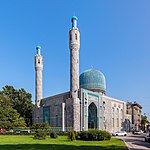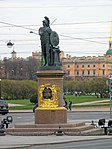Solovetsky Stone (Saint Petersburg)

The Solovetsky Stone is a monument to the victims of political repression in the Soviet Union and to those who have fought and fight for freedom. It stands in Troitskaya (Trinity) Square in Saint Petersburg, near several other buildings directly related to political repression in the Soviet era—the House of Tsarist Political Prisoners; the prison and necropolis of the Peter and Paul Fortress; and the Bolshoy Dom or headquarters of the NKVD, both in the city and the surrounding Leningrad Region. Nowadays, the Stone also serves as a focus for commemorative events and for gatherings related to current human rights issues. The monument consists of a large boulder brought from the Solovetsky Islands in the White Sea, where the Solovki prison camp opened in 1923. The camp was the malignant cell which, in Solzhenitsyn's metaphor, metastazised to create the entire Gulag network of forced labour camps. The Stone is a fitting symbol of the Gulag and the related practices of political terror. The Memorial society in Petersburg was behind the creation of the monument. It was designed by Yuly Rybakov and Yevgeny Ukhnalyov, both political prisoners during the Soviet period.
Excerpt from the Wikipedia article Solovetsky Stone (Saint Petersburg) (License: CC BY-SA 3.0, Authors, Images).Solovetsky Stone (Saint Petersburg)
Petr's quay, Saint Petersburg Petrograd Side (Посадский округ)
Geographical coordinates (GPS) Address External links Nearby Places Show on map
Geographical coordinates (GPS)
| Latitude | Longitude |
|---|---|
| N 59.952313 ° | E 30.326125 ° |
Address
Жертвам политических репрессий (Соловецкий камень)
Petr's quay
197046 Saint Petersburg, Petrograd Side (Посадский округ)
Saint Petersburg, Russia
Open on Google Maps











